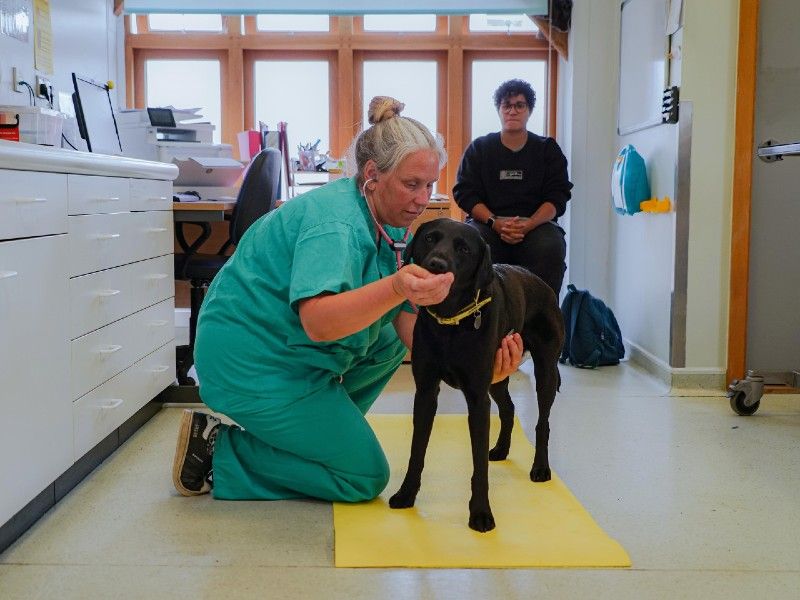Handling of dogs during consultations
Discover more about carrying out a clinical examination underpinned with behavioural considerations.

There are a number of measures clinical staff should take to establish a low-stress dog-handling technique, as follows:
Positively introduce yourself and the consulting area
The first few moments of an appointment can be invaluable in terms of settling both owner and dog and making the client feel they're getting bespoke, compassionate care.
Going right out into the waiting area to introduce yourself to the client and invite them into the consulting area, ensuring the door is held wide open, can be well worth it.
This approach also allows an opportunity to observe how the dog responds and interacts with their owner while entering the consulting area.
Put the client and their dog at ease
A dog will also be able to experience their owner’s comfort in approaching you, talking with you, and following you- for some dogs, experiencing their owner's trust in you, and comfort in your proximity and the veterinary environment can help them feel more relaxed in your presence too.
A dog who feels their owner is worried about you, or reluctant to interact with you, might mirror their owner’s hesitant, nervous behaviour. So taking time to deliberately welcome and put a client at ease is always helpful.
Let the dog come to you
Verbally acknowledging a dog, by saying their name but without directly approaching or reaching out to touch them, allows them to choose if they'd like to approach, at their own pace.
Keep your hands by your sides and allow the dog to sniff you rather than reaching out a hand towards them, as this may be experienced as overwhelming or intimidating. Especially if you are very tall and they are very small, for example.
Encourage them to enter the consulting room
Use non-contact ways to move the dog into the consulting room, if necessary, using taught cues. For example, asking the owner to call their dog to them, walk alongside them, or lure them with food trails on the floor.
Allow dogs to acclimatise to the environment by exploring and sniffing the room while you take a verbal history from the client. Encourage owners to maintain a loose lead while their dog explores, to avoid creating tension around their dog’s neck, which might constrict their airway and alarm them.
Owners can also be encouraged to scatter feed or reward their dog with treats unless contraindicated.
If the dog solicits tactile interaction by leaning into you and nudging your body or hands with their head, for example, try not to lean directly over them, as this could be seen as confrontational.
Calmly and quietly use long strokes with the whole of your hand in one slow, sweeping motion. Rather than quick, vigorous movements that might add to arousal levels and/or be experienced as unpleasant.
Carry out a clinical examination underpinned with behavioural considerations
Preparation
Most consultations are likely to require physical interaction. A behaviourally considerate approach should help them to feel safe and minimise distress and/or discomfort, while also ensuring the safety of both owner and members of staff.
It can be helpful to ask owners how their dog usually responds to being handled, and if there are any particular areas of their body where they do or do not like to be touched.
Carry out clinical examinations on a non-slip floor surface, unless considered unsafe for the patient or clinician, or the patient is experienced and comfortable with being lifted and restrained upon a table.
Approach and handling tips
- approach the patient from the side, rather than head-on, and avoid leaning over them
- remind owners that you are comfortable for their dog to move away if they wish and not to worry about holding them in position at this early stage of the interaction
- avoid direct eye-contact unless carrying out an eye examination, as sometimes this can be perceived as confrontational
- consider using treats throughout the examination (unless contraindicated as discussed above)
- this can help to build a positive association with the handling experience
- owners can be asked to treat their dog during the consultation, or treats may be scattered on the floor to avoid the additional pressure of the dog having to approach anyone to receive treats
- prolonged food-delivery systems may also be used, such as licky-mats, xylitol-free peanut butter or meat paste
- body language should still be observed throughout to ensure the dog is not enduring a handling experi ence they would rather avoid, just because the lure of the food is overriding their desire to withdraw
- take care to continue to observe the whole body when examining an area of interest, including tail position
- if the dog shows signs of not coping, then stop right away and remain calm. Feed the dog at this point if possible. Try again once the dog has relaxed
- avoid lifting a dog’s feet, unless absolutely necessary. Having limbs lifted and/or restrained reduces a dog’s choices about how to respond to a situation
- for example, a dog who is unable to avoid an interaction they are finding increasingly uncomfortable be cause a limb is being lifted for examination might begin to use more overtly repulsive behaviour to stop the interaction
- if you do need to examine a limb or paw, take care to initially position your hand at the proximal aspect of the limb next to the body. Then slide down towards the paw so they can predict you are moving towards it
- where possible, depending on the reason for examination, hold the limb in natural flexion, which is likely to be more comfortable when clipping nails, for example.
Depending on the reason for the appointment, it may be possible to conduct a consultation without handling the patient, particularly where the dog has a well-established and trusting relationship with their owner. The owner may be able to manipulate them and present any point of interest.
Consider when and how to best weigh dogs
For dogs with established negative associations around the weighing scales, weighing before the examination could risk arousing them to the point where subsequent examination becomes impossible.
It may help, therefore, to weigh dogs following any essential diagnostic interaction. The position of the scales should be optimal, avoiding busy, overcrowded areas if possible. Including a non-slip mat both on the scales themselves, but also around them, can help a dog feel confident stepping on and off them.
This will help to avoid the potential for further situation stacking should the dog find being weighed an unpleasant experience. In an ideal world, weighing scales would be seamlessly sunk into the floor.
Treats can be used to encourage a dog onto the scales (unless contraindicated) and to help them remain in position. If the owner has brought their dog’s own blanket, this might also be laid upon the scales as an additional incentive.
Suggest muzzle training
Teams at a Dog Friendly Clinic should actively encourage all owners to train their dog to wear a muzzle.
Should any clinician or owner feel it appropriate for a dog to be muzzled during their visit to the clinic while they are undergoing a muzzle-training programme, it can help to select a completely different style of muzzle to that being used for their training.
This avoids creating a negative association with the dog’s own muzzle. The clinic should therefore have muzzles of different styles and sizes for dogs with differing facial morphology.
Consider chemical restraint
Chemical restraint such as sedation, could be considered as a means of avoiding stress in dogs who appear unable to tolerate the examination or treatment while conscious.
Review appointments
Reviewing how the veterinary visit has gone can help to identify any areas that could be improved in the future. This will help to make the veterinary experience even more positive for both the owner and their dog. Asking the following questions can suggest future measures for both the clinic and the owner.
Review area | Clinic measures | Owner measures |
|---|---|---|
| Did the journey cause a problem? |
|
|
| Was the waiting room too busy? |
|
|
| Was the dog stressed in the consult room? |
|
|
| Was lifting an issue or owner restraint? |
|
|
| Was muzzling required? |
|
|
Once a plan is made to improve any future visits it should be recorded in the notes along with any relevant positives from the appointment, including preferred handling, treat preference, and what to avoid.
Handle euthanasia with sensitivity
In vet clinics, appointments involving euthanasia would be allocated additional time. Where possible, owners should be triaged in advance so they know what to expect when euthanasia is performed and are fully aware of the options available for their dog’s body following euthanasia.
Pre-euthanasia counselling gives owners the opportunity to ask questions, prepare themselves and plan, so that fully informed choices may be made without haste. Leaflets can also be given from reception and owners can also be referred for professional counselling should they find this helpful.
It can be helpful if clinics can provide a separate waiting area for owners attending an appointment for euthanasia (such as an empty consult room). Owners can wait outside, in a car or given an appointment at a quieter time, where possible.
Clinics can potentially give options for home euthanasia, or provide a service that does.
An additional consideration is the introduction of intravenous catheters to facilitate euthanasia. The clinic should also have the opportunity to sedate the patient where this is considered beneficial.
In some situations, it may be beneficial to consider the use of T-connectors and driplines to administer injectable solutions. This enables owners to hold their dogs where safe and appropriate to do so. However, this would need to be assessed on an individual basis.
Animal welfare charity Blue Cross offers a free-of-charge, confidential support service for anyone suffering the loss of a pet, whatever the reason.
The Pet Bereavement and Pet Loss Support Service is run by a team of trained and experienced volunteers, contactable by telephoning: 0800 096 6606 (operates daily between 08.30am–20.30pm all year round) or by emailing the Blue Cross team.
Join the Dog Friendly Clinic scheme
Start your journey today by visiting Dog Friendly Clinic Campus and signing up with the key: 4dLsphL2nh2x
Remember to keep note of your username, as you’ll need it each time you log in. If you’re registering on behalf of a clinic, be sure to choose a name that is clear and appropriate for your clinic.
If you don't want to join the scheme but would like to access some of our web pages, visit our Dog Friendly Clinic resources for some of our webpages containing the course content.
Need help?
If you have any questions regarding the scheme or your application, please contact our helpful Dog Friendly Clinic Team.
Disclaimer notice: The advice given on this website [in these materials] is intended for your general information only and should not be relied upon as specific advice for any veterinary practice or clinic. Each veterinary practice or clinic will be unique in its physical environment and each dog attending the veterinary practice or clinic will have specific needs and requirements, which the veterinary practice or clinic is solely responsible for. Unless prohibited by law, Dogs Trust and the British Veterinary Behaviour Association do not accept liability to any person veterinary practice or clinic relating to the use of this information.
Related articles



